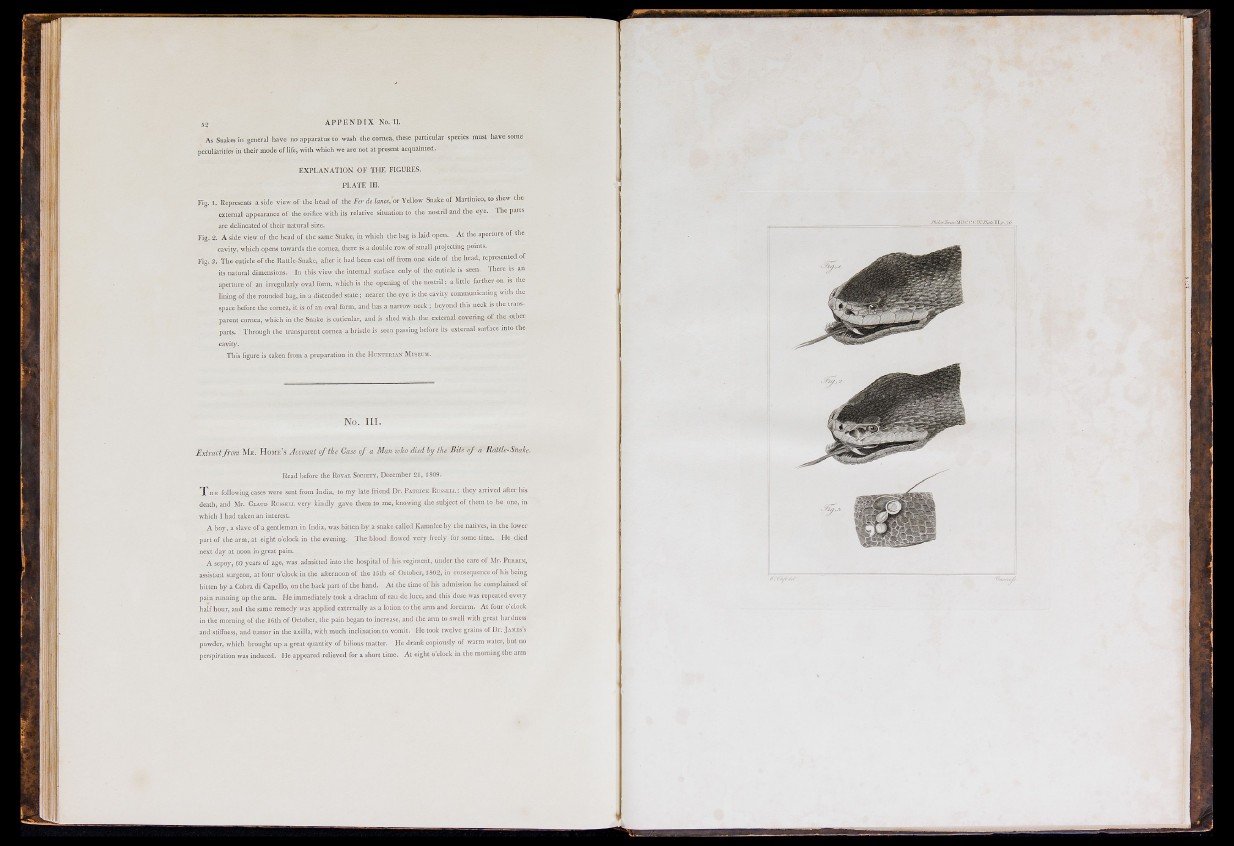
53 AP P E N D I X No. II.
As Snakes in general have no apparatus to wash the cornea, these particular species must have some
peculiarities in their mode of life, with which we are not at present acquainted.
EXPLANATION OF THE FIGURES.
PLATE III.
Fig. I. Represents a side view of the head of the Fer de lance, or Yellow Snake of Martinico, to shew the
external appearance of the orifice with its relative situation to the nostril and the eye. The parts
are delineated of their natural size.
Fig. 2. A side view of the head of the same Snake, in which the bag is laid open. At the aperture of the
cavity, which opens towards the cornea, there is a double row of small projecting points.
Fig. 3. The cuticle of the Rattle-Snake, after it had been cast off from one side of the head, represented of
its natural dimensions. In this view the internal surface only of the cuticle is seen. There is an
aperture of an irregularly oval form, which is the opening of the nostril: a little farther on is the
lining of the rounded bag, in a distended state ; nearer the eye is the cavit)- communicatiog wuh the
space before the cornea, it is of an oval form, and has a narrow neck ; beyond this neck is the transparent
cornea, which in the Snake is cuticular, and is shed with the external covering of the other
parts. Through the transparent cornea a bristle is seen passing before its external surlace mto the
cavity.
This figure is taken from a preparation In the HUSTEEIAN MusEior.
No. III.
£xlracl from MII. HOME'S Account of the Case of a Man who died hj the Bite of a Rattle-Snake.
Read before the ROYAI, SOCIETY, December 21, 1S09.
X u E following cases were sent from India, to my late friend Dr. PATKICK RDSSELL: they arrived after his
death, and Mr. CLAOD ROSSELI very kindly gave them to me, knowing the subject of them to be one, in
which I had taken an interest.
A boy, a slave of a gentleman in India, was bitten by a snake called Kamnlee by the natives, in the lower
part of the arm, at eight o'clock in the evening. The blood flowed very freely for some time. He died
next day at noon in great pain.
A sepoy, 60 years of age, was admitted into the hospital of his regiment, under the care of Mr. PEEKIN,
assistant surgeon, at four o'clock in the afternoon of the 15th of October, 1802, in consequence of his being
bitten by a Cobra di Capello, on the back part of the hand. At the time of his admission he comijlained of
pain running up the arm. He immediately took a drachm of eau de luce, and this dose was repeated every
half hour, and the same remedy was applied externally as a lotion to the arm and forearm. At four o'clock
in the morning of the 16th of October, the pain began to increase, and the arm to swell with great hardness
and stiffness, and tumor in the axilla, with much inclination to vomit. He took twelve grains of Dr. J A M E S ' S
powder, which brought up a great quantity of bilious matter. He drank copiously of warm water, but no
perspiration was induced. Fie appeared relieved for a short time. At eight o'clock in the mormng the arm